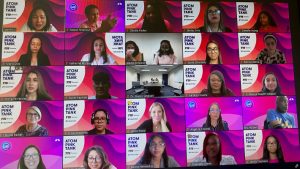Nicole Wishart and David Hinds, both PhD students in the Department of Decision Sciences and Information Systems (DSIS) in the College of Business Administration, are focusing on patterns. Though the subject matter is quite different—teaching conceptual database design and innovation communities —their findings have a number of features in common, including their practical applicability.
Nicole Wishart weighs rules versus patterns.
 Nicole Wishart |
As an instructor in the DSIS department, Wishart noticed that students were having a difficult time understanding database design. She wondered if teaching design using a pattern-based approach would be more effective than using the traditional rule-based approach.
“A rule-based approach prescribes a sequence of rules for modeling the conceptual constructs and the action to be taken at various stages while developing a conceptual model,” she said. “A pattern-based approach presents data modeling structures that occur frequently in practice and prescribes guidelines about how to recognize and use these structures.”
There is no definitive approach for database design, though Dinesh Batra, professor, DSIS, had already formulated a rule-based approach and described it in an article titled “The Use of a Knowledge-Based System in Conceptual Data Modeling.” Written with Solomon Antony (PhD ’97) and a colleague, and based on Antony’s dissertation, the article recently was ranked the tenth most downloaded paper in the journal, Decision Support Systems. A conversation with Batra prompted Wishart to examine the two approaches more closely—an examination that evolved into her dissertation.
 Dinesh Batra |
“Batra felt strongly that research would give the benefit to the rule-based approach, and in certain instances, it did,” said Wishart, who took on the subject matter with an open mind. “The rule-based approach was significantly better in the low-complexity and the high-complexity cases, but there was no statistical difference in the medium-complexity cases.”
In doing her research, which included a thorough inspection of case studies to extract what the patterns were, Wishart came to see that the idea of patterns crosses disciplines, from computer science to grammar.
“Initially, I was interested simply because it was the way that I learned, and I thought it might work for others,” she said. “I never lost faith in the pattern-based approach, but over time, I learned how to use the rule-based approach and became fond of it, eventually realizing that we need both.”
Her dissertation topic suited her practical bent, tying together cognitive studies and pedagogy without excluding conceptual methods.
“My work can be applied to practitioners,” she said. “It is very satisfying to think it may have an impact on improving teaching techniques.”
David Hinds looks at networks.
 David Hinds |
There’s a network that might be far more influential in business than ABC, CBS, or NBC. It’s called a social network, and David Hinds, working on his PhD in international management information systems, is one of the researchers involved in social network analysis (SNA). Along with Ronald M. Lee, professor, DSIS, Hinds is using SNA to reveal how certain leadership and customer involvement patterns may facilitate the building of communities and the generation of innovation.
Hinds likens the state of SNA to the invention of the microscope.
“When the microscope was first invented and used, we could see things that were previously invisible,” he said. “However, we didn’t really know what we were looking at. Similarly, we now can see social structures that we couldn’t see before, but we’re not sure yet what these structures mean.”
For his dissertation, he is analyzing Open Source Software (OSS) projects to see how groups function, how they are structured, and ways they might be improved. OSS provides an ideal repository for research.
“Archives from OSS projects are open, are maintained online, and most or all of the discussion and work records also are available online,” he said.
 Ronald M. Lee |
Through his research, Hinds hopes to shed further light on just what the networks in the OSS archives do signify. For example, he is looking for communication network patterns associated with low-key leadership styles and high levels of customer involvement, both of which he believes are important success factors for innovation communities like OSS projects.
“If we are able to show that certain network structures lead to more successful innovation efforts, the information will be valuable to managers,” he said. “They could use this knowledge to assess their own innovation communities to determine if they have the right kinds of structures or if changes might be necessary. We would be one of the pioneers in showing how to distinguish between a good network structure and a bad one.”
With twenty-five years of management, executive, and entrepreneurial experience, Hinds had always wanted to get a PhD. Having brought practical insights into his graduate work, he looks forward to “bringing academe back into business” once he completes the degree.




